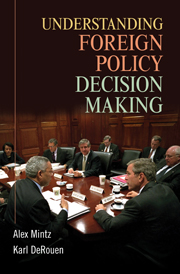Book contents
- Frontmatter
- Contents
- Acknowledgments
- PART ONE INTRODUCTION
- PART TWO THE DECISION ENVIRONMENT
- PART THREE MODELS OF DECISION MAKING
- PART FOUR DETERMINANTS OF FOREIGN POLICY DECISION MAKING
- PART FIVE MARKETING FOREIGN POLICY
- PART SIX CONCLUSION
- Appendix: Foreign Policy Simulation and Exercise
- References
- Index
Appendix: Foreign Policy Simulation and Exercise
Published online by Cambridge University Press: 05 June 2012
- Frontmatter
- Contents
- Acknowledgments
- PART ONE INTRODUCTION
- PART TWO THE DECISION ENVIRONMENT
- PART THREE MODELS OF DECISION MAKING
- PART FOUR DETERMINANTS OF FOREIGN POLICY DECISION MAKING
- PART FIVE MARKETING FOREIGN POLICY
- PART SIX CONCLUSION
- Appendix: Foreign Policy Simulation and Exercise
- References
- Index
Summary
KEY BENEFITS
Students are exposed to policy scenarios that simulate decision-making processes.
Students play the role of leaders.
Students make “actual” foreign policy decisions.
Students apply decision-making concepts, theories and models to real world situations and scenarios.
Students improve their decision-making skills through the use of a unified, systematic methodology for organizing information about a foreign policy event and analyzing policy options.
Students gain insight into the actual decision-making processes of political leaders.
- Type
- Chapter
- Information
- Understanding Foreign Policy Decision Making , pp. 177 - 178Publisher: Cambridge University PressPrint publication year: 2010

